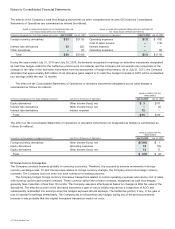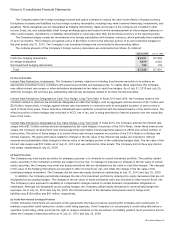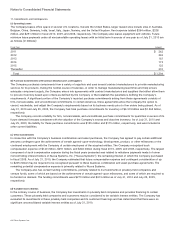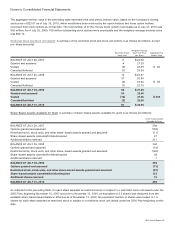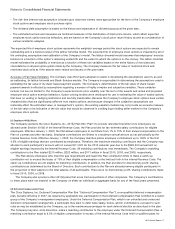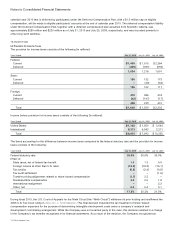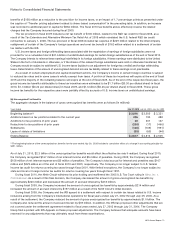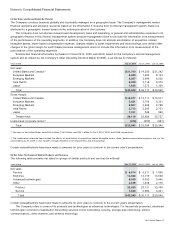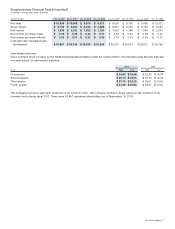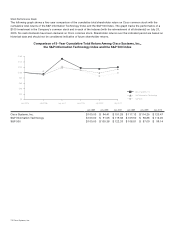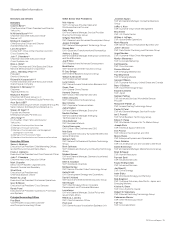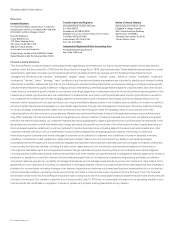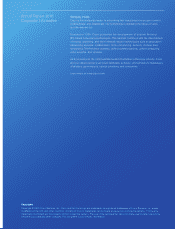Cisco 2010 Annual Report Download - page 73
Download and view the complete annual report
Please find page 73 of the 2010 Cisco annual report below. You can navigate through the pages in the report by either clicking on the pages listed below, or by using the keyword search tool below to find specific information within the annual report.
Notes to Consolidated Financial Statements
• The risk-free interest rate assumption is based upon observed interest rates appropriate for the term of the Company’s employee
stock options and employee stock purchase rights.
• The dividend yield assumption is based on the history and expectation of dividend payouts at the grant date.
• The estimated kurtosis and skewness are technical measures of the distribution of stock price returns, which affect expected
employee stock option exercise behaviors, and are based on the Company’s stock price return history as well as consideration of
various academic analyses.
The expected life of employee stock options represents the weighted-average period the stock options are expected to remain
outstanding and is a derived output of the lattice-binomial model. The expected life of employee stock options is impacted by all of
the underlying assumptions and calibration of the Company’s model. The lattice-binomial model assumes that employees’ exercise
behavior is a function of the option’s remaining vested life and the extent to which the option is in-the-money. The lattice-binomial
model estimates the probability of exercise as a function of these two variables based on the entire history of exercises and
cancellations on all past option grants made by the Company. The Company measures the fair value of restricted stock and
restricted stock units as if the awards were vested and issued on the grant date.
Accuracy of Fair Value Estimates The Company uses third-party analyses to assist in developing the assumptions used in, as well
as calibrating, its lattice-binomial and Black-Scholes models. The Company is responsible for determining the assumptions used in
estimating the fair value of its share-based payment awards. The Company’s determination of the fair value of share-based
payment awards is affected by assumptions regarding a number of highly complex and subjective variables. These variables
include, but are not limited to, the Company’s expected stock price volatility over the term of the awards and actual and projected
employee stock option exercise behaviors. Option-pricing models were developed for use in estimating the value of traded options
that have no vesting or hedging restrictions and are fully transferable. Because the Company’s employee stock options have certain
characteristics that are significantly different from traded options, and because changes in the subjective assumptions can
materially affect the estimated value, in management’s opinion, the existing valuation models may not provide an accurate measure
of the fair value or be indicative of the fair value that would be observed in a willing buyer/willing seller market for the Company’s
employee stock options.
(c) Employee 401(k) Plans
The Company sponsors the Cisco Systems, Inc. 401(k) Plan (the “Plan”) to provide retirement benefits for its employees. As
allowed under Section 401(k) of the Internal Revenue Code, the Plan provides for tax-deferred salary contributions for eligible
employees. Effective January 1, 2009, the Plan allows employees to contribute from 1% to 75% of their annual compensation to the
Plan on a pretax and after-tax basis. Employee contributions are limited to a maximum annual amount as set periodically by the
Internal Revenue Code. Effective January 1, 2009, the Company matches pretax employee contributions up to 100% of the first
4.5% of eligible earnings that are contributed by employees. Therefore, the maximum matching contribution that the Company may
allocate to each participant’s account will not exceed $11,025 for the 2010 calendar year due to the $245,000 annual limit on
eligible earnings imposed by the Internal Revenue Code. All matching contributions vest immediately. The Company’s matching
contributions to the Plan totaled $210 million, $202 million, and $171 million in fiscal 2010, 2009, and 2008, respectively.
The Plan allows employees who meet the age requirements and reach the Plan contribution limits to make a catch-up
contribution not to exceed the lesser of 75% of their eligible compensation or the limit set forth in the Internal Revenue Code. The
catch-up contributions are not eligible for matching contributions. In addition, the Plan provides for discretionary profit-sharing
contributions as determined by the Board of Directors. Such contributions to the Plan are allocated among eligible participants in
the proportion of their salaries to the total salaries of all participants. There were no discretionary profit-sharing contributions made
in fiscal 2010, 2009, or 2008.
The Company also sponsors other 401(k) plans that arose from acquisitions of other companies. The Company’s contributions
to these plans were not material to the Company on either an individual or aggregate basis for any of the fiscal years presented.
(d) Deferred Compensation Plans
The Cisco Systems, Inc. Deferred Compensation Plan (the “Deferred Compensation Plan”), a nonqualified deferred compensation
plan, became effective in 2007. As required by applicable law, participation in the Deferred Compensation Plan is limited to a select
group of the Company’s management employees. Under the Deferred Compensation Plan, which is an unfunded and unsecured
deferred compensation arrangement, a participant may elect to defer base salary, bonus, and/or commissions, pursuant to such
rules as may be established by the Company, up to the maximum percentages for each deferral election as described in the plan.
The Company may also, at its discretion, make a matching contribution to the employee under the Deferred Compensation Plan. A
matching contribution equal to 4.5% of eligible compensation in excess of the Internal Revenue Code limit for qualified plans for
2010 Annual Report 71



